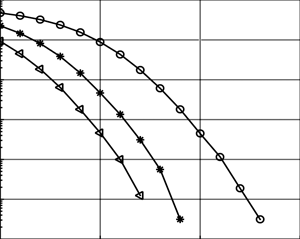Space-time-frequency coding for MIMO relay system based on tensor decomposition
DOI:
https://doi.org/10.3103/S073527272002003XKeywords:
KRSTF, MIMO relay, semi-blind receiver, asymmetric nested PARAFAC, Khatri-Rao, space-time-frequency codingAbstract
Space-time-frequency (STF) coding can obtain the diversity gain from three dimensions (space, time and frequency) to effectively improve the transmission performance of the multi-input multi-output (MIMO) relay system. In this study, a MIMO one-way two-hop amplify-and-forward (AF) relay communication system is presented by means of triple Khatri–Rao space-time-frequency (KRSTF) coding, which forms a five-dimensional tensor at the destination node that satisfies a new multi-dimensional tensor decomposition approach called asymmetric nested PARAFAC decomposition (ANPD). Then based on this model, a semi-blind receiver is derived to perform the joint channel and symbol estimation in terms of three-step alternating least squares (ALS) algorithm. Compared with the existing two-hop symmetry methods, the proposed scheme uses an asymmetric nested model to obtain additional frequency coding diversity, which significantly improves the performance of the system in parameter estimation accuracy as demonstrated by simulation results.References
- A. B. Kokhanov, “Automatic Synchronizer of Digital Signals and Telecommunication Streams,” Radioelectron. Commun. Syst., vol. 62, no. 4, pp. 181–188, Apr. 2019, doi: https://doi.org/10.3103/S0735272719040046.
- Z. Chen, P. Fan, and D. O. Wu, “Joint Power Allocation and Strategy Selection for Half-Duplex Relay System,” IEEE Trans. Veh. Technol., vol. 66, no. 3, pp. 2144–2157, Mar. 2017, doi: https://doi.org/10.1109/TVT.2016.2570816.
- X. Liang, Z. Ding, and C. Xiao, “On linear precoding of nonregenerative MIMO relay networks for finite-alphabet source,” IEEE Trans. Veh. Technol., vol. 66, no. 11, pp. 9761–9775, Nov. 2017, doi: https://doi.org/10.1109/TVT.2017.2717925.
- M. H. Shariat and S. Gazor, “Optimal non-regenerative linear MIMO relay for orthogonal space time codes,” IEEE Signal Process. Lett., vol. 21, no. 2, pp. 163–167, Feb. 2014, doi: https://doi.org/10.1109/LSP.2013.2295919.
- K. C. Lee, C. P. Li, T. Y. Wang, and H. J. Li, “Performance analysis of dual-hop amplify-and-forward systems with multiple antennas and co-channel interference,” IEEE Trans. Wirel. Commun., vol. 13, no. 6, pp. 3070–3087, 2014, doi: https://doi.org/10.1109/TWC.2014.042814.130047.
- R. Zhao, H. Lin, Y. C. He, D. H. Chen, Y. Huang, and L. Yang, “Secrecy Performance of Transmit Antenna Selection for MIMO Relay Systems with Outdated CSI,” IEEE Trans. Commun., vol. 66, no. 2, pp. 546–559, Feb. 2018, doi: https://doi.org/10.1109/TCOMM.2017.2747554.
- L. H. Lim and P. Comon, “Multiarray signal processing: Tensor decomposition meets compressed sensing,” Comptes Rendus - Mec., vol. 338, no. 6, pp. 311–320, Jun. 2010, doi: https://doi.org/10.1016/j.crme.2010.06.005.
- A. Cichocki et al., “Tensor decompositions for signal processing applications: From two-way to multiway component analysis,” IEEE Signal Process. Mag., vol. 32, no. 2, pp. 145–163, Mar. 2015, doi: https://doi.org/10.1109/MSP.2013.2297439.
- N. D. Sidiropoulos, L. De Lathauwer, X. Fu, K. Huang, E. E. Papalexakis, and C. Faloutsos, “Tensor Decomposition for Signal Processing and Machine Learning,” IEEE Trans. Signal Process., vol. 65, no. 13, pp. 3551–3582, Jul. 2017, doi: https://doi.org/10.1109/TSP.2017.2690524.
- F. Roemer and M. Haardt, “Tensor-based channel estimation (TENCE) for two-way relaying with multiple antennas and spatial reuse,” in ICASSP, IEEE International Conference on Acoustics, Speech and Signal Processing - Proceedings, 2009, pp. 3641–3644, doi: https://doi.org/10.1109/ICASSP.2009.4960415.
- F. Roemer and M. Haardt, “Tensor-based channel estimation and iterative refinements for two-way relaying with multiple antennas and spatial reuse,” IEEE Trans. Signal Process., vol. 58, no. 11, pp. 5720–5735, Nov. 2010, doi: https://doi.org/10.1109/TSP.2010.2062179.
- Y. Rong, M. R. A. Khandaker, and Y. Xiang, “Channel estimation of dual-hop MIMO relay system via parallel factor analysis,” IEEE Trans. Wirel. Commun., vol. 11, no. 6, pp. 2224–2233, Jun. 2012, doi: https://doi.org/10.1109/TWC.2012.032712.111251.
- X. Han, A. L. F. de Almeida, and Z. Yang, “Channel estimation for MIMO multi-relay systems using a tensor approach,” EURASIP J. Adv. Signal Process., vol. 2014, no. 1, pp. 1–14, Dec. 2014, doi: https://doi.org/10.1186/1687-6180-2014-163.
- L. R. Ximenes, G. Favier, A. L. F. De Almeida, and Y. C. B. Silva, “PARAFAC-PARATUCK semi-blind receivers for two-hop cooperative MIMO relay systems,” IEEE Trans. Signal Process., vol. 62, no. 14, pp. 3604–3615, Jul. 2014, doi: https://doi.org/10.1109/TSP.2014.2328323.
- J. Du, C. Yuan, and J. Zhang, “Semi-blind parallel factor based receiver for joint symbol and channel estimation in amplify-and-forward multiple-input multiple-output relay systems,” IET Commun., vol. 9, no. 6, pp. 737–744, Apr. 2015, doi: https://doi.org/10.1049/iet-com.2014.0553.
- L. R. Ximenes, G. Favier, and A. L. F. De Almeida, “Semi-Blind Receivers for Non-Regenerative Cooperative MIMO Communications Based on Nested PARAFAC Modeling,” IEEE Trans. Signal Process., vol. 63, no. 18, pp. 4985–4998, Sep. 2015, doi: https://doi.org/10.1109/TSP.2015.2454473.
- G. Favier, C. A. R. Fernandes, and A. L. F. De Almeida, “Nested Tucker tensor decomposition with application to MIMO relay systems using tensor space-time coding (TSTC),” Signal Processing, vol. 128, pp. 318–331, Nov. 2016, doi: https://doi.org/10.1016/j.sigpro.2016.04.009.
- D. S. Rocha, G. Favier, and C. A. R. Fernandes, “Tensor coding for three-hop MIMO relay systems,” in Proceedings - IEEE Symposium on Computers and Communications, 2018, vol. 2018-June, pp. 384–389, doi: https://doi.org/10.1109/ISCC.2018.8538497.
- N. D. Sidiropoulos and R. S. Budampati, “Khatri-Rao space-time codes,” IEEE Trans. Signal Process., vol. 50, no. 10, pp. 2396–2407, Oct. 2002, doi: https://doi.org/10.1109/TSP.2002.803341.
- N. D. Sidiropoulos, R. Bro, and G. B. Giannakis, “Parallel factor analysis in sensor array processing,” IEEE Trans. Signal Process., vol. 48, no. 8, pp. 2377–2388, Aug. 2000, doi: https://doi.org/10.1109/78.852018.
- J. B. Kruskal, “Three-way arrays: rank and uniqueness of trilinear decompositions, with application to arithmetic complexity and statistics,” Linear Algebra Appl., vol. 18, no. 2, pp. 95–138, Jan. 1977, doi: https://doi.org/10.1016/0024-3795(77)90069-6.
- A. L. F. De Almeida and G. Favier, “Double Khatri-Rao space-time-frequency coding using semi-blind PARAFAC based receiver,” IEEE Signal Process. Lett., vol. 20, no. 5, pp. 471–474, 2013, doi: https://doi.org/10.1109/LSP.2013.2248149.
- N. D. Sidiropoulos and R. Bro, “On the uniqueness of multilinear decomposition of N-way arrays,” J. Chemom., vol. 14, no. 3, pp. 229–239, May 2000, doi: https://doi.org/10.1002/1099-128X(200005/06)14:3<229::AID-CEM587>3.0.CO;2-N.
- G. H. Golub and C. Reinsch, “Singular value decomposition and least squares solutions,” Numer. Math., vol. 14, no. 5, pp. 403–420, Apr. 1970, doi: https://doi.org/10.1007/BF02163027.
- G. H. Golub and C. F. Van Loan, Matrix Computations, 3rd ed. Baltimore: Johns Hopkins University Press, 1996.

Downloads
Published
2020-02-23
Issue
Section
Research Articles

